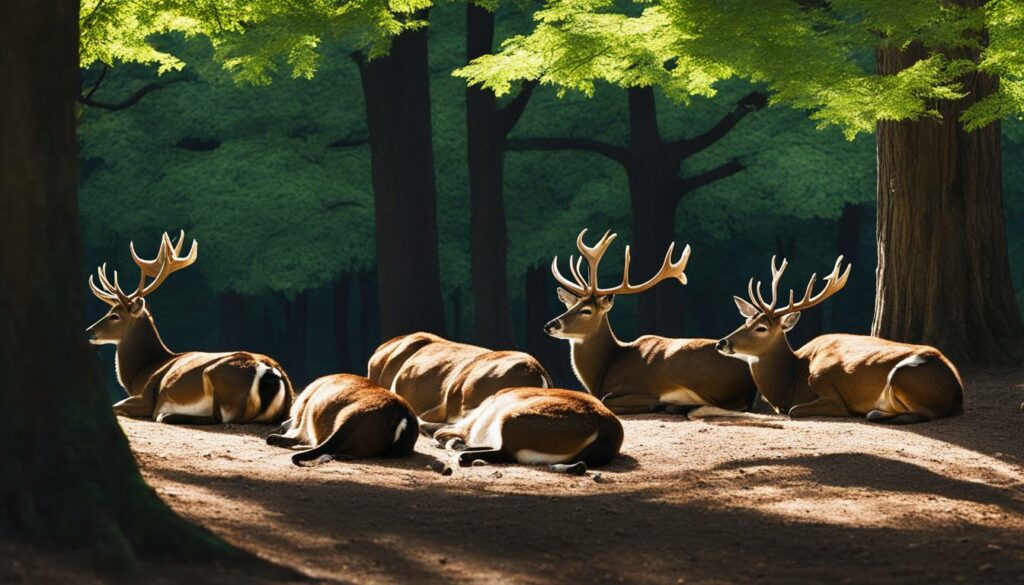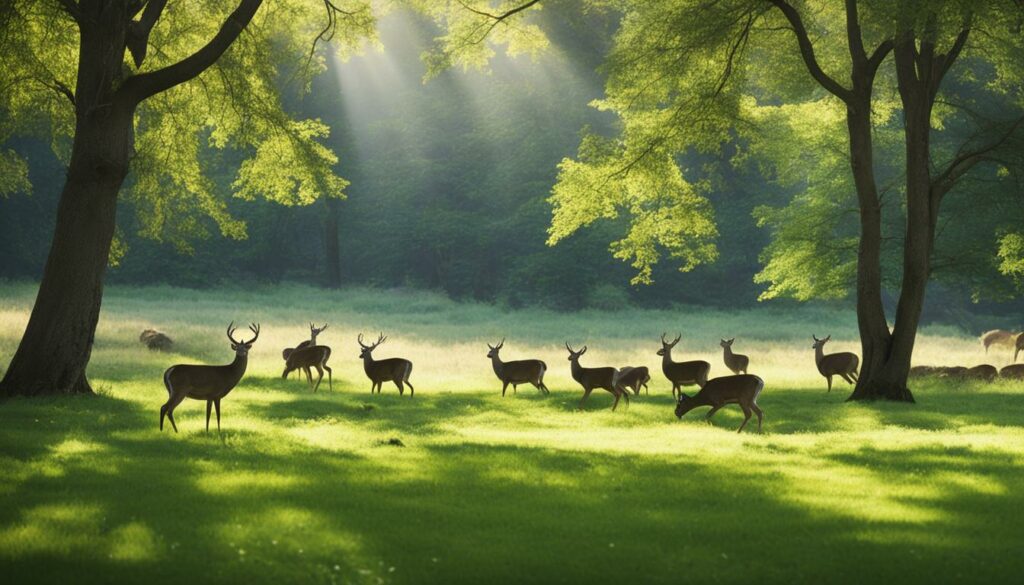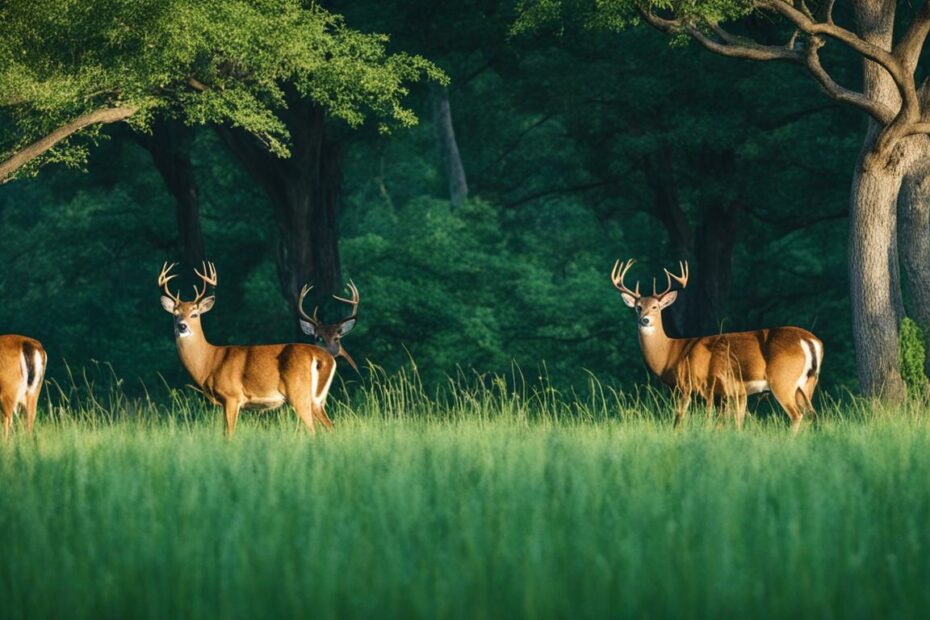Deer are fascinating creatures that exhibit unique sleeping habits. Have you ever wondered where do deers sleep and how they establish their preferred sleeping areas? In this article, we will explore the deer’s sleeping habits in detail, shedding light on their sleep patterns, preferred bedding areas, and the factors influencing their sleep behavior.
Deer can sleep anywhere they bed down, either alone or in groups. They often seek out locations that provide a sense of security, preferring to sleep in heavy cover where they can feel protected.
These areas can include dense underbrush, tall grass, and forests with low-hanging branches and shadows. Additionally, deer tend to bed near reliable water sources to have easy access when needed.
How Do Deer Sleep?
Deer have unique sleeping habits that distinguish them from other animals. While they can sleep standing up, they prefer to lie in a comfortable bed. This allows them to relax and conserve energy fully.
Deer’s sleep patterns consist of short “cat naps” rather than long periods of deep sleep. They remain alert while dozing, constantly monitoring their surroundings for potential threats. Their noses and ears are constantly working to keep them safe.
To better understand the sleep patterns of deer, let’s take a closer look at their sleeping habits:
1. Comfortable Bedding
Deer searches for a suitable sleeping spot, often choosing areas with soft ground or vegetation. They create a bed by trampling down grass or leaves, making it more comfortable for their rest.
2. Short “Cat Naps”
Deer sleep in short bouts, alternating between dozing and being alert. These intermittent naps allow them to remain aware of their surroundings. Even during sleep, deer are ready to react to any potential danger.
3. Constant Monitoring
Deer’s survival instincts drive them to be constantly alert, even while sleeping. Their acute sense of hearing and smell helps them detect predators or unfamiliar noises. They can quickly wake up and escape from potential threats.
4. Preferred Sleeping Positions
Deer utilize different sleeping positions to ensure their safety and comfort. They may sleep with their head on the ground, on their side, or in an upright position. Sleeping positions may vary based on environmental factors such as temperature and the presence of other animals.
To illustrate the sleeping positions of deer, here is a visual representation:
| Sleeping Position | Description | |
|---|---|---|
| Head on the ground | This position allows deer to rest comfortably while keeping their senses alert. | |
| On their side | Deer may choose this position to relax their muscles while still being ready to react quickly if needed. | |
| Upright position | In this position, deer can remain standing while resting, enabling them to escape from potential danger quickly. |
Where Do Deer Prefer to Sleep?
Deer have specific preferences when it comes to choosing their sleeping locations. They seek out areas that provide them with adequate cover and protection. These locations offer them a sense of security during their resting hours. Deer commonly select the following places to bed down:
- Tall grass: Deer often opt for tall grasses as they provide excellent concealment. The dense vegetation helps them blend into their surroundings and stay hidden from potential predators.
- Thick underbrush: Another favorite sleeping spot for deer is thick underbrush. The dense vegetation and tangled branches offer them added protection and shelter.
- Thick trees and forests: Deer also prefer areas with thick trees and forests. The low-hanging branches and shadows create a fortified environment where they feel safe and secure.
In addition to these factors, deer tend to bed near reliable water sources. This allows them easy access to hydration while minimizing the risk of predator encounters during their vulnerable sleeping state.
When Do Deer Sleep?
Deer are fascinating creatures with unique sleep patterns that adapt to their environment and the changing seasons. Understanding when deer sleep can provide valuable insights for hunters and wildlife enthusiasts alike.
Deers are most active during dawn and dusk, known as crepuscular. During this time, they engage in feeding and other essential activities. However, deer primarily sleep during the middle of the day to avoid the heat or cold, depending on the season.
Their sleep patterns can vary based on the time of year. During the summer months, when the days are longer, deer tend to have more activity during the night and shorter periods of sleep during the day. In contrast, during cold winter days, when resources are scarce, deer may sleep for longer durations to conserve energy.
While deer are predominantly diurnal animals, their behavior is influenced by temperature, food availability, and predation risk. Adapting their sleep patterns allows them to maximize their chances of survival in their natural habitat.
Understanding the when and why behind deer sleep can help hunters strategize their hunting efforts, and wildlife enthusiasts gain a deeper appreciation for these magnificent creatures.
Let’s take a closer look at the sleep patterns of deer during different seasons:
Deer Sleep Patterns by Season
| Season | Sleep Patterns |
|---|---|
| Summer | More activity during the night, shorter periods of sleep during the day |
| Winter | Less activity during the night, longer periods of sleep during the day |
Things Hunters Don’t Know
Deer Assign Lookouts while Sleeping
When deer sleep, they typically designate one or two individuals to act as “lookouts” while the rest of the herd rests. These lookout deer are responsible for remaining alert and scanning their surroundings for potential threats, ensuring the safety of the sleeping herd.
Disturbing Bedding Areas Can Disrupt Sleep Patterns
Deer are creatures of habit and tend to establish bedding areas in locations that provide cover and protection. These areas are carefully chosen to ensure the safety and comfort of the herd while they sleep.
However, if these bedding areas are disturbed by human presence or other external factors, it can startle the deer and cause them to abandon their preferred sleeping spots.

Strategically Planning Hunting Locations
By gaining insight into deer sleeping behavior, hunters can strategically plan their hunting locations to their advantage. By identifying prime bedding areas and setting up hunting blinds or stands nearby, hunters can maximize their chances of encountering deer as they transition from sleep to their feeding activities.
Adapting Hunting Strategies Based on Sleep Patterns
Adapting hunting strategies based on deer sleeping patterns can significantly improve hunting success. Knowing when deer are most likely to be active and their preferred bedding areas can help hunters focus their efforts during the correct times of day and avoid disturbing areas where deer may be sleeping.
How to Use Deer Sleeping Habits to a Hunter’s Advantage
Knowing deer’s sleeping habits and their preferred bedding locations can give hunters a significant advantage. By strategically leveraging this knowledge, hunters can plan their hunting locations and maximize their chances of success. Here are some tactics hunters can employ:
1. Positioning Between Feeding and Bedding Areas
During the mornings and evenings when deer are most active, hunters can position themselves between deer feeding areas and their preferred bedding locations. This can increase deer activity in the vicinity, providing hunters opportunities to spot and target their prey.
2. Avoiding Deer Bedding Areas
While deer bedding areas can be tempting spots for hunters, it is essential to avoid disturbing them. Deers are sensitive to environmental changes and may relocate if their bedding areas are frequently disturbed.
3. Adapting Hunting Tactics
Deer sleeping patterns can vary depending on factors such as the weather and seasonal changes. To increase hunting success, hunters must adapt their tactics based on these patterns.
For example, deer may rest for extended periods during hot summer days, allowing patient hunters to observe their behavior. On the other hand, colder winter days might see deer sleeping longer to conserve energy.
The Fascinating Behavior of Bedded Bucks
One exciting aspect of buck bedding behavior is their preference for facing downwind. By positioning themselves in this way, bucks can detect potential dangers with their sensitive noses and keep a watchful eye on the direction the wind is blowing, using their keen eyesight. This strategic positioning helps them stay one step ahead of potential threats.
While bedded, bucks can assume various positions. Sometimes, they rest with their heads on the ground, fully immersing themselves in their surroundings. Other times, bucks may lie on their side, offering them a comfortable resting position.
Bucks may even choose to rest in an upright position, allowing them to react quickly if necessary. This flexibility in resting positions showcases the adaptability and agility of these majestic animals.
Bedded bucks also utilize their downtime for essential activities. They rest to conserve energy, digest their food, and groom themselves. This self-care routine helps them maintain their physical health and well-being while they are bedded down.

Fascinating Bedded Buck Behavior: A Summary
To summarize, bedded bucks exhibit fascinating behavior that showcases their instinctual survival skills:
- They prefer to rest alone, unlike those who bed in family groups.
- Bucks face downwind to detect danger with their noses and watch with their eyes.
- They can rest in various positions, including head on the ground, on their side, or in an upright stance.
- While bedded, bucks engage in essential activities such as resting, digesting, and grooming.
Understanding the unique behavior of bedded bucks provides valuable insights into the world of deer and can help hunters and wildlife enthusiasts appreciate the magnificence of these creatures.
Conclusion
Understanding deer sleeping habits is crucial for hunters and wildlife enthusiasts to gain insights into deer behavior. Deer are light sleepers and remain alert even while dozing. They prefer to sleep in secure and comfortable bedding areas, often in heavy cover or near water sources.
Knowing when and where deer sleep can help hunters plan hunting strategies and avoid disturbing bedding areas. The fascinating behavior of bedded bucks provides a glimpse into the intriguing world of deer in their natural habitat.
